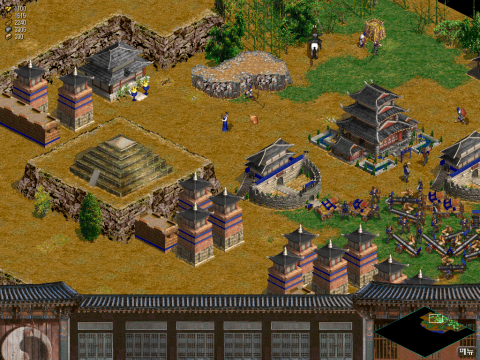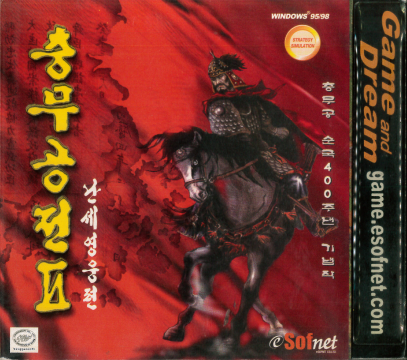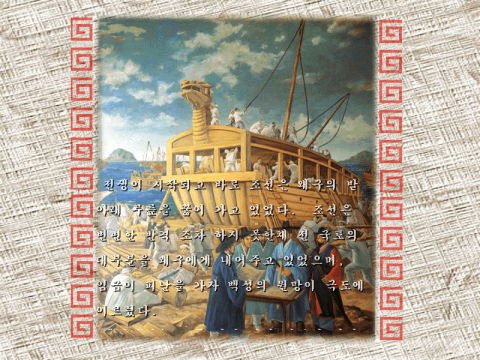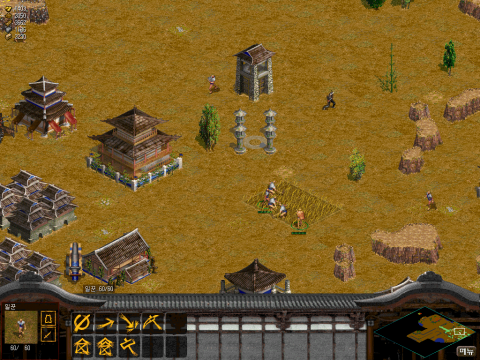After HQ Team developed their own sequel to War Diary titled Seven Years War, Trigger Soft released the direct sequel, Chungmugong Jeon II: Nanse Yeong-ung Jeon, in 1999. The setting remained the same, and once more brought the Japanese invasions of Korea to home computers. Some of the more unique gameplay elements were retained, but other than that, Chungmugong Jeon II: Nanse Yeong-ung Jeon – whose name roughly translates as “War Diary II: War Hero’s Story” – is an entirely different game than its predecessor. Unlike said predecessor, it never left Korea, and was not localized for any foreign market.
The most notable difference is the addition of Japan as a playable faction with distinct structures and units. The basic setup for both factions is the same: Workers are trained in the headquarters and then used to raise further structures and gather resources scattered across the map. The resources are used to expand, upgrade, and train soldiers, with the ultimate goal of wiping out the enemy.
The other structures available to both factions are ones expected for the setting and genre: There are various buildings to produce units, such as the barracks, shipyard, and temple, tech buildings such as the academy and cannon manufactory, as well as defense structures, such as walls and towers.
This straightforward setup is made a little more complex by said resources, of which there are five: Gold is primarily used for units and upgrades, wood for buildings and war machines, ore for advanced units, and stone for defense structures. Lastly, there is food, which is consumed by all units over time. During a shortage of food, all units will gradually lose health. While they retain at least a single hit point even when no food is available, running low on food is absolutely crippling.
The plethora of different resources forces the player to make strategic choices right from the start. Mining stone to build may allow them to set up towers to neutralize early raids by the opposition, whereas focusing on ore and gold allows training an army quickly. Ultimately, all resources are important for both factions, though Korea and Japan do not equally rely on all of them. All resources except for food, which regrows on replaced fields, is limited, but matches generally end before a map is exhausted.
The other main faction difference in Chungmugong Jeon II: Nanse Yeong-ung Jeon is the speed at which both factions progress. Japan starts out strong, with comparably easy access to some strong units, and then suffers a mid-game slump before it gets access to all upgrades and powerful spellcasting units. Korea starts out weak and struggles with a high resource demand early on, but excels once it unlocks the many upgrades available for its faction. The units in Chungmugong Jeon II: Nanse Yeong-ung Jeon are quite plentiful, and while almost every Korean unit has a Japanese counterpart, no two units are exactly identical. Even the basic worker units are a little different, with the Korean workers being slightly tougher. Ming China makes a short appearance in the Japanese campaign and has a custom headquarters, but is otherwise identical to the Korean side.
As in War Diary, Japan has access to arquebusers, which deliver accurate shots over a medium distance. Historically, Japan relied on these early firearms more heavily than Korea, which is reflected in the many, many upgrades available for this specific unit. Simpler but nevertheless deadly is the Japanese swordsman. With armor superior to that of all other low-tier units, the swordsman is a popular unit for rush strategies in multiplayer games.
More advanced units include the cannon, which distributes death and destruction over a long distance. Curiously, the Japanese cannon seems to be a perpetual motion machine and has no cannoneer. This design choice has in-game consequences. As a pure machine – in contrast to the Korean cannon, which is moved and used by an actual person – the cannon cannot regenerate health by consuming food. The same is true for Japan’s high-end siege unit, the siege tower. Essentially an even bigger cannon, it can squish smaller units under its spiked wheels.
The last two units than Japan actually trains are its two ships, the sea transport and the warship, as well as its armored land transport. The latter is a mostly pointless unit; it moves only marginally faster than most land units, and once it is destroyed, all infantry inside it perishes with it. To make matters worse, it is neither armed nor can it be repaired. More useful are the samurai and the ninja. Instead of training these, the player has to build a mansion, and then upgrade it into training grounds for either unit. After that, any low-tier soldier can be transformed into an even deadlier swordsman or an infiltrator.
The samurai is a faster and tougher swordsman. Dressed in elegant clothes, the samurai slaughters most enemy units within seconds, with its only drawback being the lack of a ranged attack. The ninja is even faster, but very fragile. Its poison dart kills organic units in a single hit, but is difficult to use effectively. More interesting is the ninja’s ability to jump up and over obstacles cliffs. It is the only unit being able to do so. However, the usefulness of this skill is highly situational, and on some maps, it has no application at all.
Alternatively, units can be retrained into a witch or a shaman – which implies that these seemingly magical transformations are magical indeed, as they change sex and age. The shaman has a couple of offensive spells as well as the ability to mind-control enemy units. The witch can drain the health of her enemies, but is primarily a summoner. She can conjure an ice monster, rock monster, or wind monster. The health of these monsters declines constantly, but until they disappear, they provide a nice boost for the rank of the Japanese. As the monsters can be summoned, a Japanese player at the end of the tech tree can harass their opponents almost for free. As powerful as the spellcasters are, they still have to rely on their recharging mana bars. Some of the other units have access to minor spells too; the samurai, for example, can boost units around him with a war cry.
The Korean side has a similar but different selection of units. Instead of a swordsman, they have access to a spearman, and the arquebuser is replaced by an archer. The Korean commander, the samurai counterpart, can switch between bow and sword, and functions an improved but overpriced upgrade of both basic units. Nevertheless, the Koreans also have a distinct swordsman unit of their own, which feels a bit redundant.
Unlike the Japanese, the Koreans do not convert any units, and almost all of them are trained at the barracks. To unlock all of them, Korea relies on building upgrades and researchable technologies, which results in their aforementioned fragility early during a match. However, they truly shine at the top of the tech tree. Late-game, Korea boasts thrice-upgraded towers, archers than can apparently shoot three arrows at once, and their infamous turtle ships. These armored behemoths – a callback to the first War Diary – are not only outright better than any Japanese ship, but have access to upgrades on top of that. Japan has no naval tech whatsoever, which makes sea-based maps a one-sided affair.
Equally one-side are most campaign maps. Chungmugong Jeon II: Nanse Yeong-ung Jeon offers a campaign for both sides with a total of twenty-four missions. Most of these are based on historical battles. In-between, voiced briefings, text interludes, and cutscenes detail the course of the war. Nevertheless, the story can be confusing for the uninitiated. Sometimes months or years pass between missions, and the player is left wondering why everything went downhill all of a sudden. On the Korean side, the events focus mainly on Admiral Yi Sun-shin, who shifted the tide of the war with a series of naval victories. On the Japanese side, the campaign is kept historically accurate for the most part. No matter the performance, Japan will eventually lose.
The missions themselves mostly consist of traditional base building with the occasional twist: Units need to be rescued, enemy generals assassinated, and multiple bases being managed at once. The AI generally has the upper hand and start with full bases and upgrades, throwing wave after wave of units at the player. This imbalance is especially noticeable with the ranged units. Whereas the high-tier cannon upgrades are denied to the player in most missions, the AI has them on every single map, outranging player units all the time. Even more frustrating are the tactical missions. With a small strike force and virtually no backup, the player has to crawl across the map, carefully micromanaging every single encounter. Without knowledge of the enemy positions and the map layout, these missions are almost impossible.
The mission difficulty is all over the place. In some early missions, the AI has easy access to some advanced tech, which makes them disproportionally challenging. Some maps offer plenty of resources, and player victory is just a matter of time, whereas others throw multiple enemy factions at a starving player. Later in the campaign, the some Korean missions are almost trivial due to the overpowered Korean warships.
The Japanese suffer the reverse, though this could be intentional to represent the Japan’s failure to secure Korea. Nevertheless, no mission is impossible – with the exception of the final Japanese mission. Here, the player finds themselves sandwiched between Joeson and Ming, with little space to expand, few resources, facing wave after wave of fully upgraded enemy troops from multiple sides.
Some of the mission objectives can be quite inconsistent. Several missions, especially on the Korean side of things, require the player to burn down all enemy structures except for walls, and hunt down each and every unit on the map. Others require only the destruction of all enemy camps, and some only the destruction of all headquarters. In one mission for the Koreans, the player has to assassinate two Japanese commanders. Most of the time, the two stay in their respective base and only leave it to defend it, but occasionally, they wander straight into the player’s base defenses – most likely a dense wall of towers – and get themselves killed, turning the mission into an unintentional speedrun.
The AI is otherwise on par for the time of Chungmugong Jeon II: Nanse Yeong-ung Jeon ‘s release. The enemy AI is not a genius, but knows how to mix assault squads, rebuilds all buildings including towers consistently after they have been razed, and uses all spells and special abilities. The AI of the player units defends itself properly, but tends to be overzealous. After disposing of incoming enemy units, the player units often leave their position. This leaves them unprotected and sometimes even in range of enemy base defenses, and makes constant babysitting necessary. The one exception to the overall acceptable AI are naval units. Navigating on open waters and being ranged, commanding naval units should be trivial. It is anything but that. Ships often refuse to follow orders or do not return fire. Interestingly, the AI suffers from the same issue: About one in three AI naval attacks ends up with the AI ships coming into range of the player ships, only to float there doing nothing while the player ships sink them one by one.
Chungmugong Jeon II: Nanse Yeong-ung Jeon has less distinguishing features than War Diary. While this makes the game less unique, it also makes it more playable, as fiddly subsystems such as limited ammunition and equipping individual units were abandoned. Some of these subsystems were transformed: The marketplace still exists, but now serves as a structure to get easy access to food instead of a mandatory and tedious-to-use trading hub. Horses can be trained separately. They come in three colors and varying qualities, and almost any units can be put on their back for a dramatic speed boost.
Most unique are probably the seasons and the weather. During a match, the game cycles through all four seasons, which has more than just cosmetic effects. During winter, shallow water freezes over and opens new paths, and the Japanese ice monster lasts four times as long. When it trains, certain crossings are flooded and become impassible. This adds a nice semi-random strategic element
Chungmugong Jeon II: Nanse Yeong-ung Jeon is presented in the isometric view popularized by fellow historical real-time strategy game Age of Empires. The slightly cartoonish graphics have been replaced by more realistic models and a little more diversity in map assets. While solid for its time, Chungmugong Jeon II: Nanse Yeong-ung Jeon suffers from a couple of issues. There is only a single tileset, and while the seasons add some color to the game, most maps are just an assortment of trees, cliffs, resources, and some water. The naval-focused maps probably have the greatest variety, but the rest looks like maps generated by a competent but uninspired random map generator. Even the campaign maps are mostly interchangeable and some even seem to be partial copies of other maps.
The game does offer a couple cutscenes. They are miles better than the ones from the original War Diary, but use some strange filters and feel disconnected from the campaign events. Most of them just show battle scenes that do not even directly relate to the previous or upcoming mission. The soundtracks and sound effects are likewise unremarkable. They fulfil their purpose, but do not stand out. The voice acting during the text interludes and mission briefing is rather dramatic – especially with the Japanese narrator – but that is not necessarily a bad thing, and it adds some character.
At the end of the day, Chungmugong Jeon II: Nanse Yeong-ung Jeon is a solid real-time strategy game for its time. For those who know the basics of real-time strategy, it is playable even without knowledge of the Korean language. The backdrop of the Imjin War, which is not widely known outside East Asian, can present both a bonus feature and an additional barrier of entry, and is probably one of the reasons why the game never left Korea.





